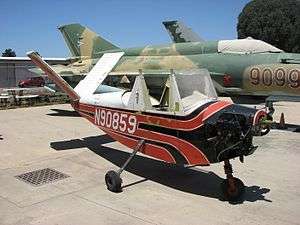Beecraft Honey Bee
| Honey Bee | |
|---|---|
 | |
| Bee Aviation Honeybee awaiting restoration at the San Diego Air & Space Museum | |
| Role | Homebuilt aircraft |
| National origin | United States |
| Manufacturer | Bee Aviation Associates, Inc. |
| Designer | Walter Mooney |
| First flight | 12 July 1952 |
| Introduction | 1952 |
| Number built | 1 |
|
| |
The Beecraft Honey Bee was an all-metal V-tailed homebuilt aircraft, that was designed by Walter Mooney and first flown on 12 July 1952.[1]
Design and development
The Honey Bee was designed and built by Walter Mooney[2]
The Honey Bee is a single seat all metal, high-wing, tricycle gear-equipped aircraft with a V-tail. The stressed skin aircraft is designed to accommodate wing flaps and slots.[3]
The prototype was test flown by William Chana on 12 July 1952 and certified on 17 December 1953.[4]
Aircraft on display
The Honey Bee prototype now is on display at the San Diego Air & Space Museum. It is the lone Bee aircraft to survive an arson fire at the museum.
Specifications (Honey Bee)
Data from Air Trails
General characteristics
- Crew: 1
- Length: 17 ft (5.2 m)
- Wingspan: 29 ft (8.8 m)
- Wing area: 95 sq ft (8.8 m2)
- Airfoil: NACA 4418
- Empty weight: 550 lb (249 kg)
- Gross weight: 860 lb (390 kg)
- Powerplant: 1 × Continental A-65 , 65 hp (48 kW)
- Propellers: 2-bladed
Performance
- Maximum speed: 104 kn; 193 km/h (120 mph)
- Rate of climb: 1,100 ft/min (5.6 m/s)
- Wing loading: 8.95 lb/sq ft (43.7 kg/m2)
- Power/mass: 13.25lb/hp
References
- ↑ Air Trails: 76. Winter 1971. Missing or empty
|title=(help) - ↑ "Bee Aviation Associates". Retrieved 8 February 2012.
- ↑ "Sweet Little Plane". Flying: 53. October 1952.
- ↑ The Aeroplane, Volume 86. p. 222.
This article is issued from Wikipedia - version of the 7/15/2016. The text is available under the Creative Commons Attribution/Share Alike but additional terms may apply for the media files.